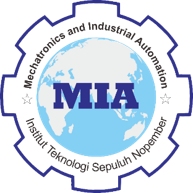Computational Fluid Dynamics (CFD) Simulation of Mixing Tank at Milk Powder Factory to Reduce Material Losses
Abstract
Keywords
Full Text:
PDFReferences
U. Sumarwan Megawati Simanjuntak and L. Noor Yuliati, “Meta-Analysis Study: Reading Behavior Of Food Products Label,” 2017. [Online]. Available: http://repository.unair.ac.id/
P. Zhu et al., “Simulating industrial spray-drying operations using a reaction engineering approach and a modified desorption method,” Drying Technology, vol. 29, no. 4, pp. 419–428, Jan. 2011, doi: 10.1080/07373937.2010.501928.
C. Muriana, “A focus on the state of the art of food waste/losses issue and suggestions for future researches,” Waste Management, vol. 68, pp. 557–570, 2017, doi: https://doi.org/10.1016/j.wasman.2017.06.047.
C. Anandharamakrishnan, J. Gimbun, A. G. F. Stapley, and C. D. Rielly, “A Study of Particle Histories during Spray Drying Using Computational Fluid Dynamic Simulations,” Drying Technology, vol. 28, no. 5, pp. 566–576, May 2010, doi: 10.1080/07373931003787918.
J. Butz et al., “Raman spectroscopy for the process analysis of the manufacturing of a suspension metered dose inhaler,” J Pharm Biomed Anal, vol. 54, no. 5, pp. 1013–1019, 2011, doi: https://doi.org/10.1016/j.jpba.2010.12.007.
M. B. Anthony, “Analisis Penerapan Total Productive Maintenance (TPM) Menggunakan Overall Equipment Efectiveness (OEE) Dan Six Big Losses Pada Mesin Cold Leveller PT. KPS,” vol. 2, no. 2, pp. 94–103, 2019.
G. A. Blekas, “Food Additives: Classification, Uses and Regulation,” in Encyclopedia of Food and Health, B. Caballero, P. M. Finglas, and F. Toldrá, Eds., Oxford: Academic Press, 2016, pp. 731–736. doi: https://doi.org/10.1016/B978-0-12-384947-2.00304-4.
C. Sharma, D. Malhotra, and A. S. Rathore, “Review of Computational fluid dynamics applications in biotechnology processes,” Biotechnol Prog, vol. 27, no. 6, pp. 1497–1510, Nov. 2011, doi: https://doi.org/10.1002/btpr.689.
Y. Zhiyin, “Large-eddy simulation: Past, present and the future,” Chinese Journal of Aeronautics, vol. 28, no. 1, pp. 11–24, 2015, doi: https://doi.org/10.1016/j.cja.2014.12.007.
A. Sarkar and H. Singh, “Emulsions and Foams Stabilised by Milk Proteins,” in Advanced Dairy Chemistry: Volume 1B: Proteins: Applied Aspects, P. L. H. McSweeney and J. A. O’Mahony, Eds., New York, NY: Springer New York, 2016, pp. 133–153. doi: 10.1007/978-1-4939-2800-2_5.
R. K. Thakur, Ch. Vial, and G. Djelveh, “Influence of operating conditions and impeller design on the continuous manufacturing of food foams,” J Food Eng, vol. 60, no. 1, pp. 9–20, 2003, doi: https://doi.org/10.1016/S0260-8774(03)00005-0.
T. HUPPERTZ, “Foaming properties of milk: A review of the influence of composition and processing,” Int J Dairy Technol, vol. 63, no. 4, pp. 477–488, Nov. 2010, doi: https://doi.org/10.1111/j.1471-0307.2010.00629.x.
M. Ritota, M. G. Di Costanzo, M. Mattera, and P. Manzi, “New Trends for the Evaluation of Heat Treatments of Milk,” J Anal Methods Chem, vol. 2017, p. 1864832, 2017, doi: 10.1155/2017/1864832.
S. Faisal, A. Bukhari, and W. Yang, “Multi-interface Level Sensors and New Development in Monitoring and Control of Oil Separators,” Sensors, vol. 6, pp. 380–389, 2006, [Online]. Available: http://www.mdpi.org/sensors
A. Afzal, Z. Ansari, A. R. Faizabadi, and M. K. Ramis, “Parallelization Strategies for Computational Fluid Dynamics Software: State of the Art Review,” Archives of Computational Methods in Engineering, vol. 24, no. 2, pp. 337–363, 2017, doi: 10.1007/s11831-016-9165-4.
P. N. Anh, J. S. Bae, and J. H. Hwang, “Computational fluid dynamic analysis of flow rate performance of a small piezoelectric-hydraulic pump,” Applied Sciences (Switzerland), vol. 11, no. 11, Jun. 2021, doi: 10.3390/app11114888.
J. H. Bucklow, R. Fairey, and M. R. Gammon, “An automated workflow for high quality CFD meshing using the 3D medial object,” in 23rd AIAA Computational Fluid Dynamics Conference, in AIAA AVIATION Forum. American Institute of Aeronautics and Astronautics, 2017. doi: doi:10.2514/6.2017-3454.
R. Bois, O. Adriao, G. Delaplace, I. Pezron, A. Nesterenko, and E. van-Hecke, “Influence of process variables on foaming ability of surfactants: Experimental study and dimensional analysis,” Chemical Engineering Research and Design, vol. 165, pp. 40–50, 2021, doi: https://doi.org/10.1016/j.cherd.2020.10.021.
X. Wang, G. M. Evans, and P. Stevenson, “Flooding in a Vertically Rising Gas–Liquid Foam,” Ind Eng Chem Res, vol. 53, no. 14, pp. 6150–6156, Apr. 2014, doi: 10.1021/ie4001844.
J. Sun et al., “A comparison of numerical simulations with experimental and theoretical investigations of highly-viscous oil-aqueous foam horizontal flow,” J Pet Sci Eng, vol. 201, p. 108507, 2021, doi: https://doi.org/10.1016/j.petrol.2021.108507.
L. P. Martínez-Padilla, V. García-Mena, N. B. Casas-Alencáster, and M. G. Sosa-Herrera, “Foaming properties of skim milk powder fortified with milk proteins,” Int Dairy J, vol. 36, no. 1, pp. 21–28, 2014, doi: https://doi.org/10.1016/j.idairyj.2013.11.011.
DOI: http://dx.doi.org/10.12962%2Fj23378557.v9i1.a16323
Refbacks
- There are currently no refbacks.
This work is licensed under a Creative Commons Attribution 4.0 International License. IPTEK The Journal of Engineering published by Pusat Publikasi Ilmiah, Institut Teknologi Sepuluh Nopember.
Please contact us for order or further information at: email: iptek.joe[at]gmail.com Fax/Telp: 031 5992945. Editorial Office Address: Pusat Riset Building 6th floor, ITS Campus, Sukolilo, Surabaya 60111, Indonesia.








